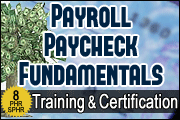How To Handle Payroll Wage Garnishments
Best-Selling Training Courses:
Instructor-Led: Webinars
Online Training Courses
About Payroll Garnishment Rules - And How To Handle Garnishments
 What Is A Wage Garnishment?
What Is A Wage Garnishment?A wage garnishment is a legal mechanism designed to enforce payment of debts and ensure that creditors receive the funds owed to them.
Essentially, a portion of an individual's earnings are required legally to be withheld by their employer in order to satisfy a debt owed to a creditor. Typically, this occurs when an individual has failed to pay a debt, such as unpaid taxes, child support, student loans, or other outstanding financial obligations.
The process of wage garnishment typically involves a court order or government agency mandate instructing the employer to withhold a certain amount of the debtor's wages and send it directly to the creditor until the debt is satisfied or a payment arrangement is made. The amount that can be garnished from a paycheck is subject to both federal and state laws, which dictate the maximum percentage of earnings that can be withheld.
The Common Errors In Handling Wage Garnishments
Handling wage garnishments can be complex for employers, and errors in the process can lead to legal liabilities and financial consequences. Some common employer errors in handling wage garnishments include:
- Incorrect Calculation Of Garnishment Amount(s):
Employers must accurately calculate the amount to withhold from the employee's wages based on the garnishment order. Errors in calculation can lead to underpayment or overpayment of the debt, both of which can have legal implications. For instance, employers must know how to calculate the withholding and prioritize the order of distribution when an employee has more than one type of garnishment.
- Failure To Respond Promptly:
Employers are typically required to respond promptly to wage garnishment orders or notices. Ignoring or delaying response - for any reason - can result in penalties or fines to the employer. - Failure To Prioritize Multiple Garnishments:
If an employee has multiple garnishments, employers must prioritize them correctly based on legal requirements. Failing to do so could result in improper distribution of funds and legal issues. For example, employers receiving multiple garnishments on the same worker must determine which garnishment gets priority. - Violating The Maximum Withholding Limits:
Federal and state laws impose limits on the percentage of an employee's wages that can be garnished. Employers must ensure that they do not withhold more than the allowable limit to avoid legal consequences. - Improperly Handling Exempt Income:
Certain types of income, such as Social Security benefits or certain types of public assistance, may be exempt from garnishment. Employers must correctly identify and handle exempt income to avoid legal issues. - Employee Notification:
Employers are typically required to provide employees with timely and accurate information about wage garnishments, including the amount being withheld, the reason for the garnishment, and the affect on applicable individual retirement accounts, health savings accounts, and escrow accounts.
To avoid these errors, employers should be properly trained for handling wage garnishments and their accompanying legal requirements. Below are some sample training courses to help you learn the proper procedures.
Training For Handling Payroll Garnishments
Below are training courses for both HR departments and financial institutions for handling garnishments.
>>> For HR Departments: Garnishments 101: Processes For Handling Garnishments ProperlyAs with all of the federal and state laws, garnishment rules and regulations that must be followed to the letter - and with the constant threat of penalties for violating any one of them - it's no wonder why processing each and every garnishment is such a daunting task.
Therefore, understanding the correct process for handling garnishments, even before you might have to deal with one, is of the utmost importance, and one we'll help you conquer in this training session. By attending this informative training session, you will learn:
- State and federal law regarding garnishments

- What is the difference between a garnishment and a levy
- How to identify and define the various types of garnishments and levies
- What are the typical garnishments received by the payroll department and how should they be handled?
- What is disposable income and the order of priorities when multiple garnishments are received
- For multiple garnishments on the same worker, determining which gets priority
- Helpful tips to assist in your garnishment processing
- How to properly handle terminated employee garnishments
- How to calculate the withholding and prioritize the order of distribution when an employee has more than one type of garnishment
- Best practices for processing garnishments
More Details / Order:
http://www.PayrollTrainingCenter.com/showWCtDetails.asp?tcid=1000337>>>For Financial Institutions: Dealing with Subpoenas, Summonses, Garnishments, Tax LeviesThis webinar provides attendees with the best practices and red flags for dealing with the various legal documents served upon financial institutions. By attending, you will learn:

- Legal differences among subpoenas, summonses, levies, garnishments, writs of attachments and warrants
- What your financial institution should know about the Right to Financial Privacy Act, the Financial Privacy Act, and similar laws and regulations
- Verifying customer information when complying with subpoenas, garnishments, and levies
- Helpful resources to assist your financial institution when complying with these orders
- Whether IRS tax levies will attach to special accounts, like individual retirement accounts, health savings accounts, and escrow accounts
- An overview of procedures for answering garnishments of federal benefit payments
More Details / Order:
http://www.PayrollTrainingCenter.com/dealing-with-subpoenas-summonses-garnishments-tax-levies-etc-wt1000514Other Payroll Garnishment Training Courses
Either select a recommended course below or use the search box to find other payroll garnishment training courses.
Featured Course:
Paycheck Fundamentals Training & Certification ProgramThe Paycheck Fundamentals Training & Certification Program helps beginning and intermediate HR professionals learn the basic payroll requirements.
The Program includes plain-English descriptions of the various requirements, processes, and procedures, as well as numerous examples, administrative tips, and interactive Q&A to help provide valuable insight into compliance requirements. The Program also includes an optional test for those who wish to earn the "Certified Paycheck Fundamentals Administrator" designation. This Program also qualifies for eight hours of PHR and SPHR re-certification credits!

Besides the basics, you will also learn to:
- Identify, pay, and withhold taxes for employees
- Handle deferred compensation, cafeteria plan, sick pay, and other compensation
- Properly provide stock options, expense reimbursements, relocation, and other "expenses"
- Follow the proper policies, procedures, and documentation requirements for garnishments and levies
More Details / Order:
https://www.payrolltrainingcenter.com/paycheck-fundamentals-training-and-certification-program-ot1000061Best-Selling Training Courses:
Instructor-Led: Webinars
Online Training Courses
Top FAQs
Employers generally have to notify the debtor in writing that a wage garnishment is about to start before sending payments to the creditor. The wage garnishment then typically continues until the debts are paid off or otherwise resolved. Employers are required to provide employees with a copy of garnishment paperwork.
The amount of pay subject to garnishment is based on an employee's "disposable earnings", which is the amount left after legally-required deductions are made. Employers should be aware that there are two general types of garnishments, one for child support and one for creditors (commonly referred to as "levies").
Yes. For child support orders, the maximum amount that can be withheld runs between 50 (if the employee is supporting another spouse and/or children) and 65% (if the employee is not supporting another spouse and/or children and is at least 12 weeks in arrears in making support payments).
Find Seminars, Webinars, And Online Training In Your Area
About Payroll Garnishments: Employer Garnishment Rules & Guidelines
Employer Guidelines For Handling GarnishmentsEmployers generally have to notify the debtor in writing that a wage garnishment is about to start before sending payments to the creditor. The wage garnishment then typically continues until the debts are paid off or otherwise resolved. Employers are required to provide employees with a copy of garnishment paperwork.
Is There A Limit To How Much Can Be Garnished?The amount of pay subject to garnishment is based on an employee's "disposable earnings", which is the amount left after legally-required deductions are made. Employers should be aware that there are two general types of garnishments, one for child support and one for creditors (commonly referred to as "levies").
- Re child support orders, the maximum amount that can be withheld runs between 50 (if the employee is supporting another spouse and/or children) and 65% (if the employee is not supporting another spouse and/or children and is at least 12 weeks in arrears in making support payments).
- Re levies, many states apply the "25-30" rule, meaning.
- The "25 Rule"
The wage garnishment order cannot take more 25% of the employee's "disposable earnings" - The "30 Rule"
The wage garnishment order can only take amounts over 30 times the federal minimum wage
Employers in states using the "25-30" rule should note that the wage garnishment cannot exceed the lesser of the two options. Be sure to check the table above to help find the rules for the states in which your organization does business.
State-By-State Payroll Garnishment Training
Learn The Payroll Garnishment Rules For Your StateA wage garnishment is any legal or equitable procedure through which some portion of a person's earnings is required to be withheld by an employer for the payment of a debt. The six basic types of garnishments are for child support, federal, state, or local levies, creditor garnishments, and student loans, with the largest amount of garnishments being for child support.
Employers should be aware or employer garnishment rules, that states have various garnishment laws, and there are often penalties for violating these laws. Don't be caught unaware! Read the state-specific information below and/or take one of our recommended garnishment training courses.








